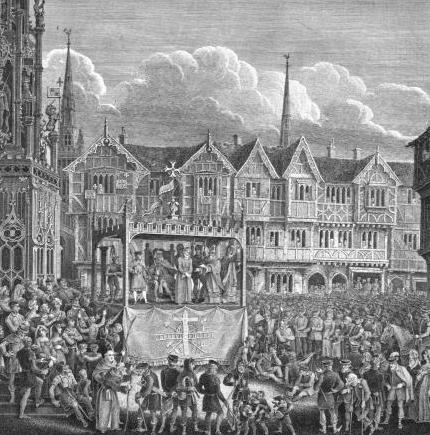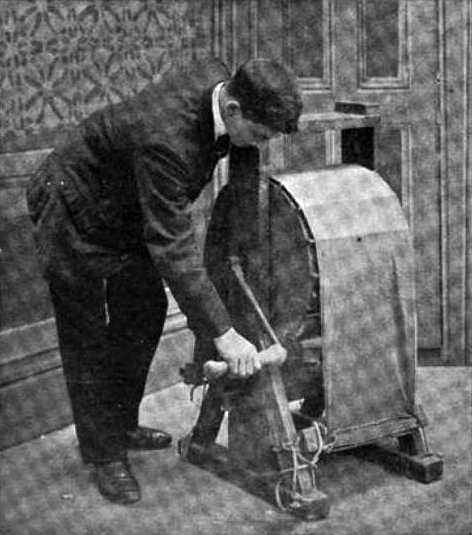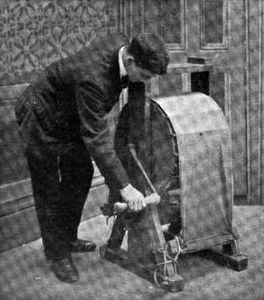Why do we use the term “property master”? In our modern world of “directors”, “managers”, and “heads”, why use the word “master”? Where does it come from?
The term “property master” is in reference to the old European guild systems. In a guild, a person would apprentice to a master for several years, learning the trade. He (or she) would then become a journeyman, traveling from one master to the next, practicing their craft in exchange for housing and a daily wage. Finally, one would apply to the guild for membership, often having to complete a masterpiece showing competence in your given trade. Only a master could run their own shop. Thus, a props master denotes one who is proficient in the craft of props, and is qualified to run a props shop.
Did props people actually belong to a guild in the Middle Ages? Probably not; as seen in my previous post, guilds supplied the props for Medieval pageants. Thus, the bread was supplied by the master bakers, and the ships provided by master shipwrights. A “property-master” would be redundant. It would appear that the term did not exist while guilds were predominant in Europe.
The term “property” was used in a theatrical sense since at least 1425 A.D. We have evidence of what these properties are from the late Middle Ages on through the Elizabethan Period. We know that the companies accumulated and stored props, that they commissioned special props from the guilds, and that the actors themselves would supply a lot of the more personal props. However, we don’t know the term for the person who would head the organization of all these props. Perhaps there was none, and the duties were split between the owners, managers, and artists of the company.
We first hear about a general “property-man” in 1749. W.R. Chetwood’s A General History of the Stage describes a property-man as “the person that receives a bill from the prompter for what is necessary in every play; as purses, wine, suppers, poison [etc.]”. The earliest occurrence of the term “property-master” I could dig up is in England in 1831. This sentence appears in “The Royal Lady’s Magazine”:
The other parts were filled as usual, Curioni being the Idreno, and Lablache the Assur. Curioni makes a woful [sic] mistake in dressing himself like a Cherokee Indian: somebody should instruct him, that there is more than one India, and that he errs in thinking he is king of that which is in the west. Talking of costume, cannot the property-master find something more resembling a crown than the bottomless tin-pot which is at present stuck on Arsace’s head.
It would appear than that the head property-man began to be called a property master well after the guilds had begun their decline. This terminology is also confusing because a props shop does not operate as a guild in the legal sense. Some occupations, such as electricians or contractors, are required to be licensed, which is similar to the requirement that a crafts-person belong to a guild in order to participate or run a shop. A property master does not need a license nor any specific schooling or degrees to operate.
Unofficially of course, a props career still operates like a guild in many ways. I began as an “apprentice in props”, followed by a property carpenter journeyman position at the Santa Fe Opera. The Actors Theatre of Louisville where I once worked also hires journeyman. (Check out “The Wanderers“, an interesting look at the modern revival of journeymen artisans in Europe.) The idea, if not the name, of journeyman can be seen in the career paths of many theatre artisans as they travel from theater to theater taking a variety of seasonal and over-hire positions to build their resumes and portfolios.
You don’t hear a lot about formal apprenticeships anymore, where a beginner spends five to seven years cleaning the shop of a master in exchange for knowledge and housing. Many theaters have apprentice programs (sometimes called “internships”) which last for a season or a year, some of which are quite good. There are of course, many other theaters which hire apprentices and interns and use them merely as cheap labor, imparting no guidance or knowledge whatsoever. We all like the satisfaction of solving a problem on our own, but the value of being taught the basics in the beginning cannot be underestimated. It is highly inefficient for so many people to be reinventing the wheel every year in theatre, especially when there so many more worthy prop challenges.
But I digress. What I’ve described here is the most reasonable sounding theory I’ve heard on why the head of a props department is called a “property-master”. If you’ve ever heard your own theories, or heard additional evidence either for or against this one, let me know!



